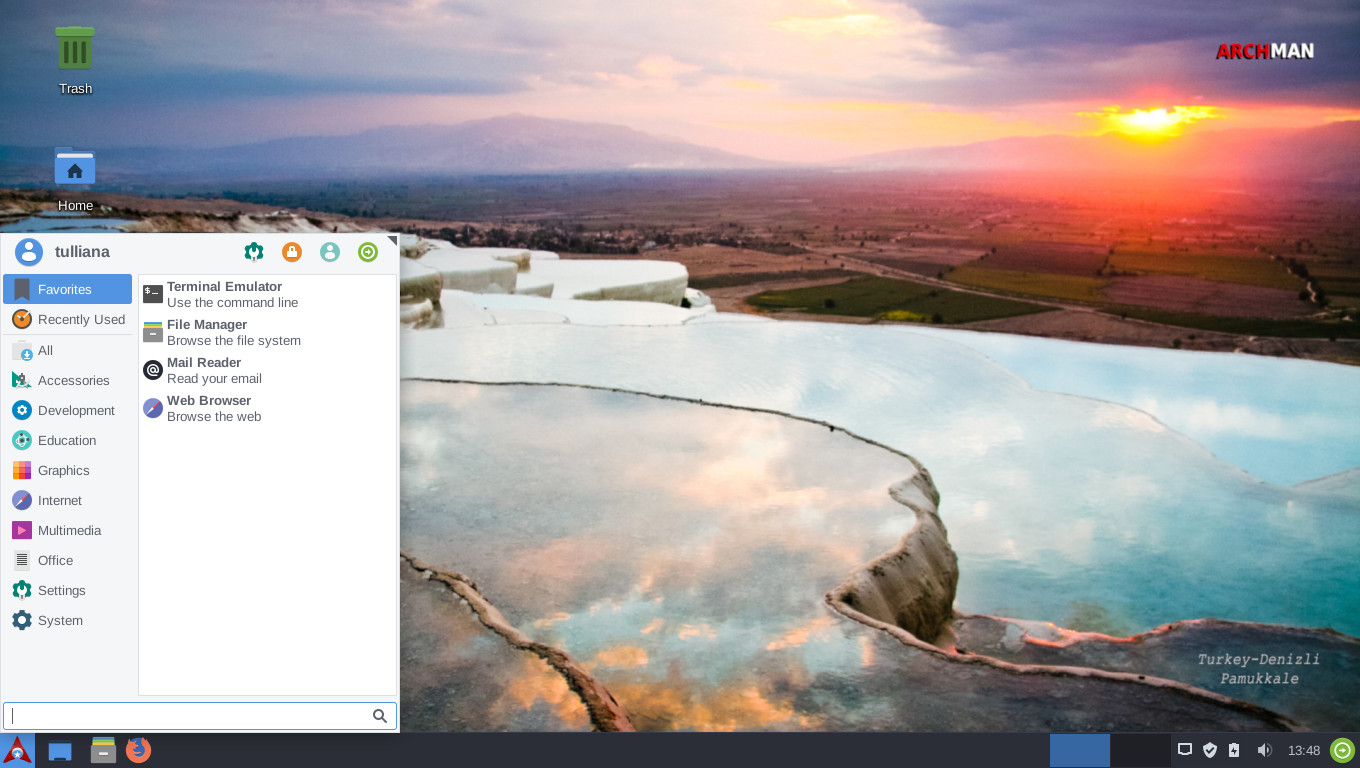Archman Xfce 18.06 Edition (Codename: Cotton Castle - Pamukkale) Released
COTTON CASTLE - PAMUKKALE
Pamukkale, meaning "cotton castle" in Turkish, is a natural site in Denizli in southwestern Turkey. The area is famous for a carbonate mineral left by the flowing water. It is located in Turkey's Inner Aegean region, in the River Menderes valley, which has a temperate climate for most of the year.The ancient Greco-Roman city of Hierapolis was built on top of the white "castle" which is in total about 2,700 metres (8,860 ft) long, 600 m (1,970 ft) wide and 160 m (525 ft) high. It can be seen from the hills on the opposite side of the valley in the town of Denizli, 20 km away.
Known as Pamukkale (Cotton Castle) or ancient Hierapolis (Holy City), this area has been drawing the weary to its thermal springs since the time of Classical antiquity.[1] The Turkish name refers to the surface of the shimmering, snow-white limestone, shaped over millennia by calcium-rich springs. Dripping slowly down the vast mountainside, mineral-rich waters foam and collect in terraces, spilling over cascades of stalactites into milky pools below. Legend has it that the formations are solidified cotton (the area’s principal crop) that giants left out to dry.
Tourism is and has been a major industry in the area for thousands of years, due to the attraction of the thermal pools. As recently as the mid-20th century, hotels were built over the ruins of Hierapolis, causing considerable damage. An approach road was built from the valley over the terraces, and motor bikes were allowed to go up and down the slopes. When the area was declared a World Heritage Site, the hotels were demolished and the road removed and replaced with artificial pools.
Overshadowed by natural wonder, Pamukkale’s well-preserved Roman ruins and museum have been remarkably underestimated and unadvertised; tourist brochures over the past 20 years have mainly featured photos of people bathing in the calcium pools. Aside from a small footpath running up the mountain face, the terraces are all currently off-limits, having suffered erosion and water pollution at the feet of tourists.
Pamukkale's terraces are made of travertine, a sedimentary rock deposited by water from the hot springs.
In this area, there are 17 hot water springs in which the temperature ranges from 35 °C (95 °F) to 100 °C (212 °F). The water that emerges from the spring is transported 320 metres (1,050 ft) to the head of the travertine terraces and deposits calcium carbonate on a section 60 to 70 metres (200 to 230 ft) long covering an expanse of 24 metres (79 ft) to 30 metres (98 ft). When the water, supersaturated with calcium carbonate, reaches the surface, carbon dioxide de-gasses from it, and calcium carbonate is deposited. Calcium carbonate is deposited by the water as a soft gel which eventually crystallizes into travertine.
Museum
In this museum, alongside historical artifacts from Hierapolis, there are also artifacts from Laodiceia, Colossae, Tripolis, Attuda and other towns of the Lycos (Çürüksu) valley. In addition to these, the museum has a large section devoted to artifacts found at Beycesultan Hüyük that includes some of the most beautiful examples of Bronze Age craft.
Artifacts from the Caria, Pisidia and Lydia regions are also on display in this museum. The museum’s exhibition space consists of three closed areas of the Hierapolis Bath and the open areas in the eastern side which are known to have been used as the library and gymnasium. The artifacts in open exhibition space are mostly marble and stone. Hierapolis is broken down into ruins.
Tourist attraction
Pamukkale is a tourist attraction. It is recognized as a World Heritage Site together with Hierapolis. Hierapolis-Pamukkale was made a World Heritage Site in 1988.
The underground volcanic activity which causes the hot springs also forced carbon dioxide into a cave, which was called the Plutonium, which here means "place of the god Pluto". This cave was used for religious purposes by priests of Cybele, who found ways to appear immune to the suffocating gas.
Tadpoles can be found in the pools.Protecting the thermal waters
The hotels built in the 1960s were demolished as they were draining the thermal waters into their swimming pools and caused damage to the terraces. Nowadays, water supply to the hotels are limited and they need to deposit the water used to the supply to generate.
Access to the terraces is not allowed and visitors are asked to follow the pathway. Due to the new regulations, visitors are only allowed to dip their feet into the small pools, with their footwear removed.
Screenshots

Release Notes and packages:
linux-4.16.13-2
pamac-aur 6.4.0-1
papirus-icon-theme-20180601-1
archman-settings-manager 0.5.5-1
archman-example-files-20180609-1
archman-wallpapers-20180609-2
archman-xfce-settings-20180531-1
archmanos-gtk3-theme-1.4.8-1
calamares 3.2.0-3
firefox-60.0.2-1
Xfce4 4.12.4-1
libreoffice-still-5.4.7-2
gimp-2.10.2-1
inkscape 0.92.3-3
virtualbox 5.2.12-2
lightdm & light-slick-greeter
Last updated drivers
Unsupprted drivers (b43-firmware-6.30.163.46-1, xf86-video-sis-0.10.8-3 ...)
AUR repos enabled
Multilib Arch repos enabled
Archman-OS Theme (combination by tulliana)
Archman background and wallpapers (Soner EKER)
Liberation Sans font
Drop-Down terminal= F12
Screenshots= PrtSc
Start Menu= Super+L (win start button)
Calamares slides (Canemir - Archman artwork developer)
click here for package list
Facilitated Terminal commands
sudo pacman -S ==> pac
sudo pacman -Ss ==> pacs
sudo pacman -Syy ==> pacu
sudo pacman -Syu ==> update
sudo pacman -Scc ==> clean
sudo pacman -R ==> remove
sudo reflector --verbose --latest 15 --sort rate --save /etc/pacman.d/mirrorlist ==> mirrors
sudo reflector --verbose --latest 15 --sort rate --save /etc/pacman.d/mirrorlist && sudo pacman -Syyu ==> upgrade
sudo pacman -Qi ==> info
HOW TO USB TRANSFER:
GUI:
Suse ImageWriter recommended to transfer usb disk on Linux and on Windows
(Suse ImageWriter on Archman repos)
Format USB disk:
sudo mkfs.vfat /dev/sd? -I
dd command:
sudo dd bs=4M if=/path/to/archman.iso of=/dev/sd? status=progress && sync
(as root or with sudo)
Update instructions:
Update your system as usual with pamac. On terminal with pacman:
update
pac release-archman
lsb_release -a
SHA1SUM
c6a31c2495885e70932e55b6afa7b04b29d3f3b3
MD5SUM
dcd32e1e6661b31611a332c13c4f9253
Please test and tell us your findings and findings about this release.
Kind regards..
tulliana...
archman.org - Bizi bilen iyi bilir, bilmeyen de kendi gibi bilir.!
Archman Xfce 18.07 Edition (Codename: Cotton Castle - Pamukkale) Released
COTTON CASTLE - PAMUKKALE
Pamukkale, meaning "cotton castle" in Turkish, is a natural site in Denizli in southwestern Turkey. The area is famous for a carbonate mineral left by the flowing water. It is located in Turkey's Inner Aegean region, in the River Menderes valley, which has a temperate climate for most of the year.The ancient Greco-Roman city of Hierapolis was built on top of the white "castle" which is in total about 2,700 metres (8,860 ft) long, 600 m (1,970 ft) wide and 160 m (525 ft) high. It can be seen from the hills on the opposite side of the valley in the town of Denizli, 20 km away.
Known as Pamukkale (Cotton Castle) or ancient Hierapolis (Holy City), this area has been drawing the weary to its thermal springs since the time of Classical antiquity.[1] The Turkish name refers to the surface of the shimmering, snow-white limestone, shaped over millennia by calcium-rich springs. Dripping slowly down the vast mountainside, mineral-rich waters foam and collect in terraces, spilling over cascades of stalactites into milky pools below. Legend has it that the formations are solidified cotton (the area’s principal crop) that giants left out to dry.
Tourism is and has been a major industry in the area for thousands of years, due to the attraction of the thermal pools. As recently as the mid-20th century, hotels were built over the ruins of Hierapolis, causing considerable damage. An approach road was built from the valley over the terraces, and motor bikes were allowed to go up and down the slopes. When the area was declared a World Heritage Site, the hotels were demolished and the road removed and replaced with artificial pools.
Overshadowed by natural wonder, Pamukkale’s well-preserved Roman ruins and museum have been remarkably underestimated and unadvertised; tourist brochures over the past 20 years have mainly featured photos of people bathing in the calcium pools. Aside from a small footpath running up the mountain face, the terraces are all currently off-limits, having suffered erosion and water pollution at the feet of tourists.
Pamukkale's terraces are made of travertine, a sedimentary rock deposited by water from the hot springs.
In this area, there are 17 hot water springs in which the temperature ranges from 35 °C (95 °F) to 100 °C (212 °F). The water that emerges from the spring is transported 320 metres (1,050 ft) to the head of the travertine terraces and deposits calcium carbonate on a section 60 to 70 metres (200 to 230 ft) long covering an expanse of 24 metres (79 ft) to 30 metres (98 ft). When the water, supersaturated with calcium carbonate, reaches the surface, carbon dioxide de-gasses from it, and calcium carbonate is deposited. Calcium carbonate is deposited by the water as a soft gel which eventually crystallizes into travertine.
Museum
In this museum, alongside historical artifacts from Hierapolis, there are also artifacts from Laodiceia, Colossae, Tripolis, Attuda and other towns of the Lycos (Çürüksu) valley. In addition to these, the museum has a large section devoted to artifacts found at Beycesultan Hüyük that includes some of the most beautiful examples of Bronze Age craft.
Artifacts from the Caria, Pisidia and Lydia regions are also on display in this museum. The museum’s exhibition space consists of three closed areas of the Hierapolis Bath and the open areas in the eastern side which are known to have been used as the library and gymnasium. The artifacts in open exhibition space are mostly marble and stone. Hierapolis is broken down into ruins.
Tourist attraction
Pamukkale is a tourist attraction. It is recognized as a World Heritage Site together with Hierapolis. Hierapolis-Pamukkale was made a World Heritage Site in 1988.
The underground volcanic activity which causes the hot springs also forced carbon dioxide into a cave, which was called the Plutonium, which here means "place of the god Pluto". This cave was used for religious purposes by priests of Cybele, who found ways to appear immune to the suffocating gas.
Tadpoles can be found in the pools.Protecting the thermal waters
The hotels built in the 1960s were demolished as they were draining the thermal waters into their swimming pools and caused damage to the terraces. Nowadays, water supply to the hotels are limited and they need to deposit the water used to the supply to generate.
Access to the terraces is not allowed and visitors are asked to follow the pathway. Due to the new regulations, visitors are only allowed to dip their feet into the small pools, with their footwear removed.
Screenshots

Release Notes and packages:
linux 4.17.5-1
pamac-aur 6.4.1-1
papirus-icon-theme-20180601-1
archman-settings-manager 0.5.5-1
archman-example-files-20180609-1
archman-wallpapers-20180609-2
archman-xfce-settings-20180531-1
archmanos-gtk3-theme-1.4.8-1
calamares 3.2.1-1
firefox-61.0.1-1
Xfce4 4.12.4-1
libreoffice-still-5.4.7-2
gimp-2.10.4-1
inkscape 0.92.3-3
virtualbox 5.2.14-1
lightdm & light-slick-greeter
Last updated drivers
Unsupprted drivers (b43-firmware-6.30.163.46-1, xf86-video-sis-0.10.8-3 ...)
AUR repos enabled
Multilib Arch repos enabled
Archman-OS Theme (combination by tulliana)
Archman background and wallpapers (Open search internet research)
Liberation Sans font
Drop-Down terminal= F12
Screenshots= PrtSc
Start Menu= Super+L (win start button)
Calamares slides (Canemir - Archman artwork developer)
click here for package list
You can install using the f2fs file system on SSD disks
Facilitated Terminal commands
sudo pacman -S ==> pac
sudo pacman -Ss ==> pacs
sudo pacman -Syy ==> pacu
sudo pacman -Syu ==> update
sudo pacman -Scc ==> clean
sudo pacman -R ==> remove
sudo reflector --verbose --latest 15 --sort rate --save /etc/pacman.d/mirrorlist ==> mirrors
sudo reflector --verbose --latest 15 --sort rate --save /etc/pacman.d/mirrorlist && sudo pacman -Syyu ==> upgrade
sudo pacman -Qi ==> info
HOW TO USB TRANSFER:
GUI:
Suse ImageWriter recommended to transfer usb disk on Linux and on Windows
(Suse ImageWriter on Archman repos)
Format USB disk:
sudo mkfs.vfat /dev/sd? -I
dd command:
sudo dd bs=4M if=/path/to/archman.iso of=/dev/sd? status=progress && sync
(as root or with sudo)
Update instructions:
Update your system as usual with pamac. On terminal with pacman:
update
pac release-arcman
lsb_release -a
SHA1SUM
c7ca9a7f1bc480f077a5da43b7803aebe6cdeb2f
MD5SUM
8ddef4cdc9f5209c1d54ce463feb94f8
Please test and tell us your findings and findings about this release.
Kind regards..
tulliana...
archman.org - Bizi bilen iyi bilir, bilmeyen de kendi gibi bilir.!


